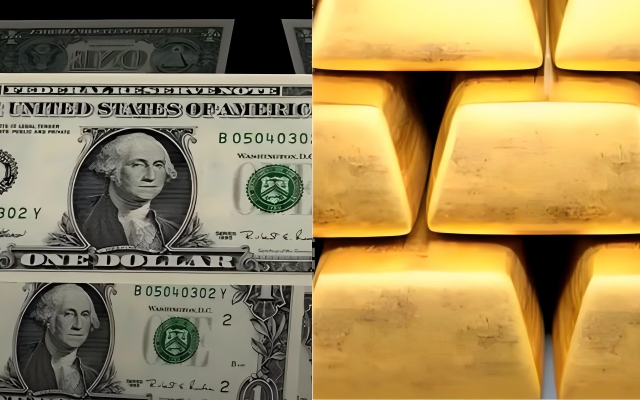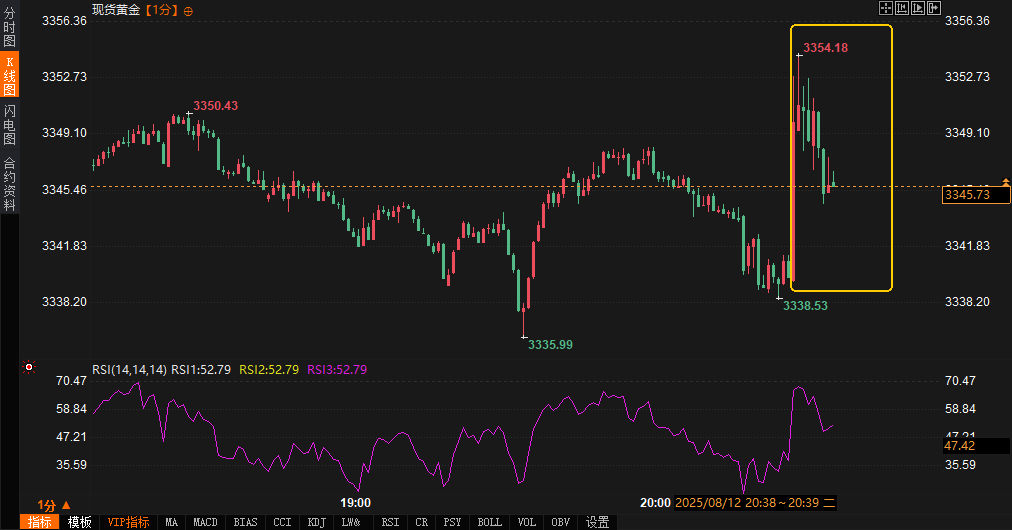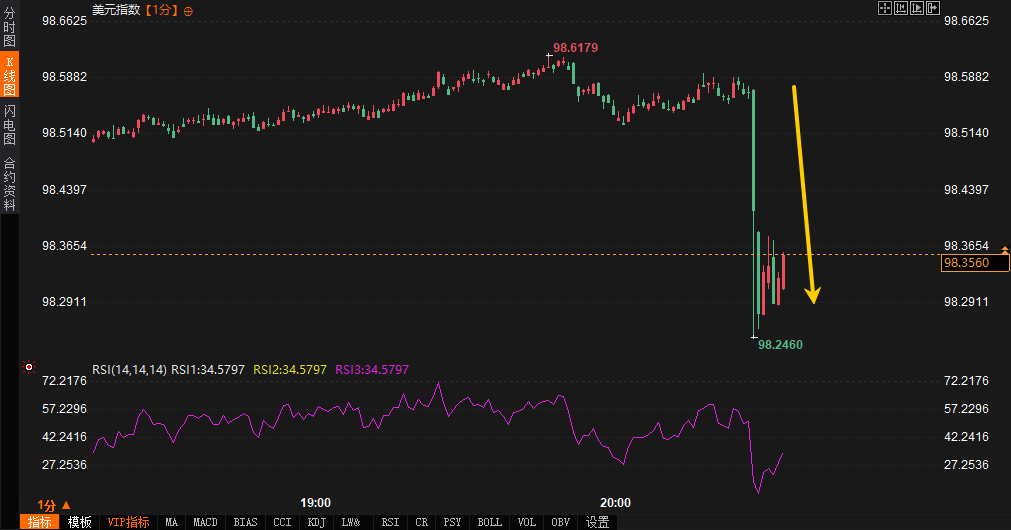US CPI Flash Report: Gold's $15 blitz exposes weaknesses, the US dollar plunges 33 points, and the US Treasury yield's 4.3% defense line shows a fatal crack.
2025-08-12 20:52:15
Financial markets reacted swiftly to the data release: the US dollar index plunged approximately 33 points, spot gold briefly surged by about $15 to $3,354.18 per ounce before retreating nearly $10, and the 10-year Treasury yield fell 0.2 basis points to 4.271%. Market sentiment fluctuated significantly amid concerns about data quality and growing expectations of a September Federal Reserve rate cut. This article analyzes the market's immediate reaction, evolving expectations of a rate cut, and the interpretations of institutional and retail investors, and looks ahead to future trends.

Market reaction: Gold prices rebounded in the short term, the US dollar came under pressure, and US Treasury yields slowed.
After the data was released, financial markets exhibited a typical pattern of "rising first, then falling." The US dollar index plummeted sharply after the CPI data fell short of expectations, falling approximately 33 points in a short period of time, reflecting the market's initial interpretation of easing inflationary pressures. Gold prices surged in the short term on growing expectations of rate cuts, with spot gold briefly reaching $3,354.18 per ounce. However, profit-taking and a higher-than-expected core CPI figure subsequently pulled back nearly $10, ultimately settling around $3,345 per ounce, down approximately 0.3% from the previous day. The reaction in the US Treasury market was relatively muted, with the 10-year Treasury yield falling slightly to 4.271% and the 2-year yield falling 1.5 basis points to 3.739%, indicating that market concerns about short-term inflationary pressures have eased.


Compared to historical trends, gold prices have fluctuated upward over the past month due to risk aversion triggered by tariff rhetoric, reaching a record high of $3,393.7 per ounce in late July. However, on August 11th, the price plummeted 2.8%, reflecting the market's sensitivity to inflation and policy expectations. The US dollar index has recently rebounded, rising approximately 1.5% since late July. However, the short-term decline triggered by the CPI data suggests that the market reacted more directly to lower-than-expected inflation figures. US Treasury yields have remained volatile at elevated levels over the past two weeks, with the 10-year yield fluctuating between 4.2% and 4.3%. The subsequent decline following the data release suggests that market expectations for easing Federal Reserve policy have intensified.
Interest rate cut expectations and market sentiment: Cooling inflation strengthens expectations of a September rate cut
The July CPI data provided significant guidance for the Federal Reserve's monetary policy expectations. While the month-over-month increase in core CPI exceeded expectations, the year-over-year growth in overall inflation fell short of expectations. Combined with the weak July non-farm payroll data (only 73,000 new jobs, well below expectations), market expectations for a September Fed rate cut have been further reinforced. According to interest rate futures market data, the probability of a 25 basis point rate cut in September has risen from 85% before the data release to 92%, while the probability of a 50 basis point cut has also climbed from 15% to 22%. This represents a more optimistic outlook than at the end of June, when market bets on a rate cut cooled due to a rebound in inflation.
From a market perspective, the benign CPI data has eased inflation concerns previously sparked by tariff rhetoric. Reputable analysts suggest that if the month-over-month core CPI growth rate does not exceed 0.44%, the market will tend to view inflationary pressures as short-term, with limited impact on expectations of interest rate cuts. The data suggests that the food and energy components have a larger negative contribution to inflation, while the housing and core services components have a more modest positive contribution. Overall, the inflation trend has not deviated significantly from the Federal Reserve's 2% target range. This has led investors to bet that the Federal Reserve will initiate an easing cycle in September to counter the pressure of slowing economic growth.
However, data quality issues have become a focus of market concern. Due to budget and staff cuts at the BLS, CPI data collection has been limited in some regions, resulting in an increase in the use of the "differential unit imputation" method from 30% to 35% in the June data. While economists believe this method does not introduce systematic bias, the increased volatility has raised market concerns about statistical reliability. Against this backdrop, the market has become more cautious in interpreting the data, with short-term fluctuations driven more by trading sentiment than fundamentals.
Interpretation from institutions and retail investors: Diverging expectations and adjustments to trading strategies
Following the data release, institutional and retail investors showed a clear divergence in their views. Institutional investors generally focused on the data's implications for the Federal Reserve's policy path. A prominent institutional strategist noted that while the 0.3% month-over-month increase in core CPI exceeded expectations, overall inflation was below the forecast of 2.8%, indicating that the full impact of tariff rhetoric on prices has yet to materialize, leaving the Fed with room to cut interest rates in September. Another analysis suggests that a sustained rise in core CPI in the coming months (such as reaching 0.6% in August or 0.76% in September) could force the Fed to postpone a rate cut, but current data supports the view that inflation is transitory, and expectations of a rate cut are unlikely to reverse in the near term.
Retail investors' views were more emotional. Some expected the CPI data to significantly exceed expectations, pushing up the dollar and depressing gold and crypto assets. One trader predicted before the data was released that if the CPI exceeded 3% year-on-year, the S&P 500 index could fall 1-2%, and believed the Federal Reserve would delay interest rate cuts due to inflationary pressures. After the data was released, this pessimism among these investors eased somewhat, with some users turning bullish on gold and tech stocks, believing that cooling inflation would drive a rebound in risky assets. Another user questioned the data quality, suggesting that the first CPI report after the BLS leadership change might be influenced by political factors, potentially exaggerating the market reaction.
Compared to pre-data expectations, both institutional and retail investors have adjusted their views. Prior to the release, the consensus was for CPI to rise to 2.8% year-on-year, with core CPI reaching 3.0%. Some retail investors even bet on inflation exceeding 3%. The actual data fell short of expectations, prompting traders to quickly adjust their positions, with increased activity in both dollar shorts and gold longs. Institutional analysts further suggest that if subsequent data continues to fall short of expectations, the dollar could face further downward pressure, while gold and the US tech sector are expected to benefit from expectations of easing.
Outlook for future trends: Short-term fluctuations and long-term uncertainty coexist
Looking ahead, the market is likely to continue its current trend in the short term: pressure on the US dollar, upward fluctuations in gold prices, and a easing of high US Treasury yields. Gold faces strong technical resistance around $3,350/oz. If expectations of a September rate cut continue to grow, gold could challenge its all-time high of $3,400/oz, but caution should be exercised against the risk of a pullback due to profit-taking. The US dollar index finds support in the 93-94 range. If subsequent inflation data does not further exceed expectations, the US dollar is likely to remain weak and volatile. Regarding US Treasury yields, the 10-year yield has stabilized around 4.2%, but in the short term, expectations of a rate cut will keep it from breaking through the recent high of 4.3%.
Long-term, uncertainty surrounding inflation trends remains a concern. Potential upward pressure from housing inflation and core services could push up core CPI inflation in the coming months, while volatility in food and energy components could continue to weigh on overall inflation. Furthermore, the situation between Russia and Ukraine and instability in global supply chains could support energy prices, indirectly impacting inflation expectations. Investors should closely monitor the August CPI data on September 11th, as well as the wording of the Federal Reserve's September meeting, to gauge the pace and magnitude of interest rate cuts.
Regarding trading strategies, investors are advised to remain flexible amidst data-driven volatility. In the short term, investors can focus on gold long opportunities, but strict stop-loss orders should be set to mitigate the risk of a pullback. USD short positions should be wary of a potential rebound in inflation that exceeds expectations. In the US Treasury market, investors can focus on allocating to short-term bonds to balance yield volatility risks. Cross-asset hedging strategies (such as gold/USD combinations) are particularly important in the current environment of high uncertainty.
In summary, the mild performance of July's CPI data injected a brief optimism into the market and reinforced expectations of a September rate cut. However, data quality issues and upward pressure on the core CPI suggest investors remain cautious. Short-term market volatility may increase, but the long-term trend remains determined by the Federal Reserve's policy path and the evolution of the global macroeconomic environment.
- Risk Warning and Disclaimer
- The market involves risk, and trading may not be suitable for all investors. This article is for reference only and does not constitute personal investment advice, nor does it take into account certain users’ specific investment objectives, financial situation, or other needs. Any investment decisions made based on this information are at your own risk.





















